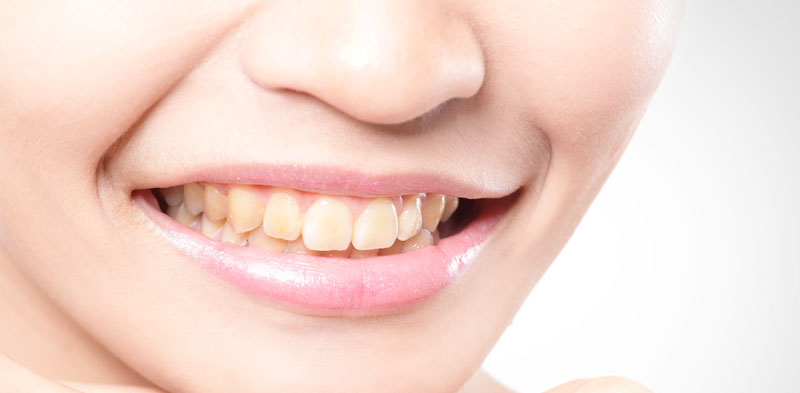Dr. Sonia Sharma

Question: My brother’s teenage aged children who have recently immigrated to Canada from a small village of India suffer from excessive light and dark stains on their teeth. Why do some people get these stains and are these stains curable? – Rajinder S. Kang, Brampton.
Dr. Sonia Sharma: People often wonder why their teeth stain. Many factors exist that can cause some form of staining in the teeth. The causes of stains that occur on outer surface are called extrinsic stains. These stains are due to:
Dietary conditions generally include excessive use of tea, coffee, chocolates, tobacco and smoking. Our community also indulges in paan masala and paan. All these edibles if used for a prolonged period of time help institute mild to severe staining of the teeth. Plaque, debris is due to poor oral hygiene, improper brushing and cleaning of teeth. Liquid vitamins containing iron are the other source of staining amongst individuals.
Other causes of staining can occur from events that occurred during development of the teeth. These are usually classified as intrinsic stains and are stained from within the tooth. Examples can include:
Intrinsic stains are usually the result of a disturbance within the tooth that occurred during the tooth’s formative years. The cells of the enamel, which are quite sensitive to any abnormal disturbances, are affected, causing the staining and discolorations. These types of stains are usually treated with more invasive measures, whereas the dentist or hygienist usually removes extrinsic stains, intrinsic stains are difficult to remove. Excessive use of tetracycline antibiotic before the age of eight can also causes intrinsic stains that are gray in color with stripes.
Black or brown discolored tooth: possible causes include trauma. If an individual is hit in the mouth or hits a tooth, the blood vessels inside the tooth hemorrhage causing the blood to enter the dentin layer. This results in a discolored tooth. It is important to note that after initial trauma to the tooth, immediate discoloration may not show. A dentist should be visited for the follow up and to confer any treatment to control this type of discoloration.
Whitish or brownish chalky spots: usually caused by excessive fluoride during the formative years.
Greenish stains: found around the necks of children’s teeth, by the gum line. This usually leaves when complete eruption of the tooth occurs. If this doesn’t happen, then the dentist or hygienist may clean the tooth.
In a study performed in Goa, India, taking 1,189 seventh grade children, it was found that 13% presented with a condition called fluorosis.
Fluorosis is a condition that occurs when chronic ingestion of more than 2 parts per million of fluoride is taken over several years during the time when the teeth are in their calcification stage. Children that were used in the study were using fluoride toothpaste before age 6 and were on untreated water. These children had twice the amount of fluorosis than children who were not exposed to fluoride up until this age.
In our society, 95% of children 6 or older use fluoridated toothpaste. The results of this study should not lead parents to believe that children of 6 or younger should not be using fluoridated toothpaste. However, parents should limit the use to a very small amount of toothpaste each time they brush, and be present to monitor the child’s brushing routine.
Some of the effects of fluorosis in mild cases are little white stains on the teeth. In more severe cases, teeth can turn a shade of brown and even break off, which all leads to more cavities.
Fortunately, most types of stains are removable or can be masked with latest cosmetic dental techniques. Simple extrinsic type of staining responds real well to general teeth cleaning and tooth whitening treatments. Internal tooth stains (intrinsic type) can only be masked with dental prosthesis. Porcelain veneers are placed on the surface of the stained teeth. Veneers are thin shells that are bonded to the teeth. This type of treatment is generally expensive and is not covered by private insurance plans.
Please visit your dentist to ascertain the nature of the stains of your relatives. Once the cause is established, your dentist will plan the treatment accordingly.
Please remember that the information is provided as general information. It is NOT intended to replace professional care. Since every patient and every case may vary, consult your physician or dentist for advice on your particular situation.
Connect With Us:
Dr. Sonia Sharma Dental Centre
12-3078 Mayfield Road,
Brampton, Ontario, L6Z 0E3
Major Intersection: Mayfield Road/Hwy10 or Hurontario St.
(905) 840-3456
1-877-216-0449
Monday : 9:00 AM - 6:00 PM
Tuesday : 9:00 AM - 6:00 PM
Wednesday : 9:00 AM - 6:00 PM
Thursday : 9:00 AM - 6:00 PM
Friday : 9:00 AM - 6:00 PM
Saturday : 8:30 AM - 4:30 PM
Sunday: By appointment only